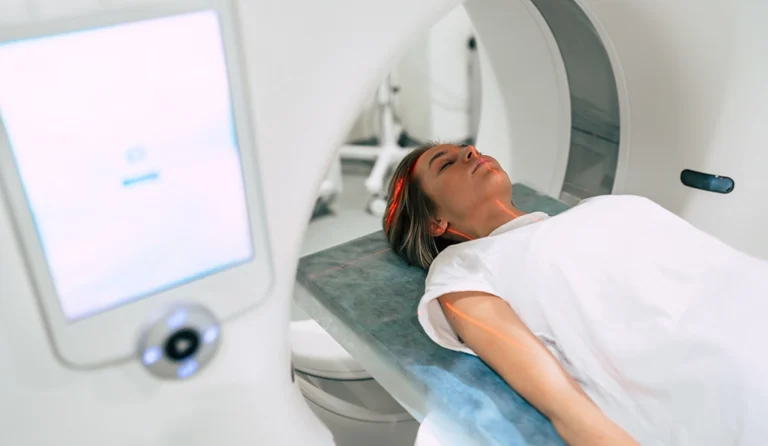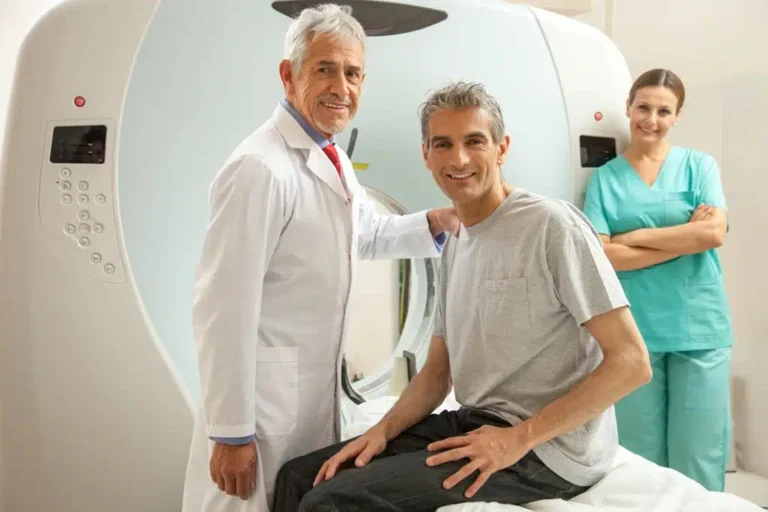If you’ve recently had an abdominal CT scan, and tried to understand your CT report, you might be feeling a little overwhelmed by the clinical and technical terms. We’re here to help you understand exactly what your results mean for your abdominal health.
In this guide, we’ll explain each of the sections in your CT report, what the findings section means for your health, how to understand the impressions section, and how to discuss your report with your healthcare provider. Let’s take a look at how you can understand the report from your abdominal CT scan.
What to know the first time you read your abdominal CT scan report
Many people feel overwhelmed the first time they read their CT report, but with a little knowledge about how it works, you’ll have a clearer understanding of what your report means. That way, you can be more confident when you discuss your results with your healthcare provider.
We will walk you through the basics, breaking down the key sections in your report, along with the purpose of each section. Let’s start by understanding what an abdominal CT scan report is designed to tell you.
What does an abdominal CT scan report tell patients?
An abdominal CT scan report is a detailed document summarizing the findings from your scan. Your CT report provides information about the organs, tissues, and structures within your abdominal area. This includes your liver, pancreas, kidneys, intestines, blood vessels, and the surrounding tissues.
The report typically highlights any abnormalities, areas of concern, or significant findings that might explain symptoms or help guide diagnosis. In some cases, it may also note incidental findings, which are things that aren’t directly related to why the scan was ordered, but could still be medically important.
What are the different sections of the report? What do they mean?
A CT scan report is usually divided into several standard sections, each with a specific focus, and each of which tells you and your provider something important about your abdominal area.
Here are the sections that many abdominal CT reports will include:
- Patient Information and Scan Details: This section includes your name, age, the date of the scan, and the technical settings used during the imaging. While it’s mostly administrative, it ensures the report belongs to you, and outlines how the scan was performed.
- Clinical Indication: This explains why the scan was ordered in the first place. It usually includes a brief description of your symptoms or the medical question your provider is trying to answer.
- Findings: This is the most detailed part of the report. It lists observations for each organ and structure examined, noting whether they appear normal or abnormal. If there are any masses, inflammation, or other irregularities, this is where they are described.
- Impressions (or Conclusion): This section summarizes the most important findings and provides a focused explanation of what they might mean. It’s designed to help your healthcare provider determine next steps.
Each section serves a distinct purpose, and together, they create a comprehensive picture of your abdominal health.
What does the clinical indication section show?
The clinical indication section is a snapshot of the reason behind your scan. This is typically a brief statement summarizing your symptoms, medical history, or the specific condition your healthcare provider is investigating.
While this section is short, it’s a critical part of the report because it guides how the radiologist interprets your images. Think of it as the question the scan is trying to answer.
View our available abdominal CT appointments at a location near you today
Interpreting key findings in your abdominal CT report
The findings section of your abdominal CT report includes info that may sound technical, but keep in mind that each term is carefully chosen to describe what the radiologist sees on the scan. In this section, we’ll break down how your findings are described, the terminology you might encounter, and how radiologists detail specific characteristics of abnormalities, like size, shape, and location.
How does the findings section describe observations in the abdomen?
The findings section is where the radiologist records everything observed in the scan, whether normal or abnormal. Each major organ in your abdomen, like your liver, pancreas, kidneys, and intestines, is assessed and described individually. If everything appears normal, you might see phrases like unremarkable findings or normal appearance of the liver.
If something unusual is detected, it will be detailed in this section. The radiologist might describe features like a mass, inflammation, or changes in the texture or appearance of an organ. These observations are often compared to what’s considered typical for someone of your age and medical background. This section is comprehensive, and includes your expected findings, along with anything that may need further investigation.
What medical terms are commonly used to describe abdominal abnormalities?
The findings section of your report includes specialized medical terms to describe any abnormalities. Here are some common terms you might encounter:
- Lesion: A general term for any abnormal tissue, which could be benign (which means it is non-cancerous) or malignant (which means it is likely cancerous).
- Mass: A lump or growth, which may be solid or fluid-filled, requiring further evaluation to understand it.
- Cyst: A fluid-filled sac that can develop in various organs, which is often harmless, but occasionally needs medical attention.
- Calcification: Deposits of calcium in tissues, which may indicate past injuries or infections.
- Dilated: Used to describe structures like blood vessels or ducts that are abnormally widened.
- Inflammation: Swelling or irritation of tissues, which often indicates an infection or irritation.
These terms help radiologists convey detailed observations in a way that is concise and informational. If you’re unsure about a term, you may find it helpful to write it down, and then discuss it with your provider.
How are the size, shape, and location of these findings typically described?
Radiologists provide precise descriptions of any abnormalities they observe, focusing on the size, shape, and location. Measurements are often given in millimeters (mm) or centimeters (cm) to indicate the size of the abnormality. This helps track any changes over time if follow-up imaging is needed.
Shape is also described to give more detail about the nature of the finding. Your report may use words like round, oval, or irregular to describe the contour of a lesion or mass. For example, a report might mention an irregularly shaped mass in the pancreas, suggesting the edges aren’t smooth and may need further evaluation.
Location is another key detail. Radiologists specify exactly where a finding is within the abdomen, often using directional terms like right upper quadrant or specific organ locations, such as the tail of the pancreas. This precise language ensures everyone involved in your care knows exactly where to focus attention.
What to know about the impression section
The impression section of your abdominal CT scan report is where all the detailed observations from the findings section are summarized. This section is especially important because it provides a clear summary that helps guide next steps in your care. Let’s dive into what this section contains and how it informs the next steps in diagnosis or treatment.
What exactly does the impression section tell me?
The impression section brings together all the key findings from the scan into a few focused conclusions, and is the radiologist’s professional interpretation of the most important observations. While the findings section lists all the details, the impression section connects the dots, and prioritizes what matters most.
If nothing significant is detected, you might see a statement like no acute abnormalities identified. This section doesn’t provide a final diagnosis, but narrows down possible diagnoses, and raises questions to be explored further.
What are some medical terms to look for in the impression section?
The impression section often includes terms that reflect the radiologist’s interpretation of the scan. Some common phrases you’ll see in this section could include:
- Consistent with: Suggests that the findings align with a particular condition, like findings consistent with pancreatitis.
- Suggestive of: Indicates a possible condition that requires further investigation, like findings suggestive of bowel obstruction.
- No acute abnormalities: A reassuring phrase indicating no urgent or concerning findings.
- Indeterminate: Used when a finding cannot be fully explained based on the scan alone, often prompting additional testing.
- Stable: Describes findings that haven’t changed since a previous scan, often used in follow-up imaging.
Recognizing these terms can help you understand how the radiologist interprets the findings and what areas may require follow-up care or monitoring.
How does this section help guide next steps in diagnosis or treatment?
The impression section plays a critical role in shaping your care plan, and helps your healthcare provider decide whether additional tests, consultations, or treatments are needed.
If the report finds no urgent issues, the next steps might involve monitoring or addressing your symptoms in other ways. The impression section also helps prioritize actions, distinguishing between findings that need immediate attention and those that can be managed later.

Discussing your abdominal CT report with your healthcare provider
Once you’ve reviewed your abdominal CT scan report, the next step is to discuss it with your healthcare provider. This conversation is your chance to ask questions, clarify terms, and understand what the findings mean for your health. Let’s look at who analyzes your report, what to expect when you discuss your report with your provider, and at some helpful questions during your discussion.
Who is responsible for analyzing my CT results? How is my CT report created?
A radiologist, which is a doctor who specializes in interpreting medical imaging, will analyze your CT scan results. They review the images from your scan, identify any abnormalities, and summarize their findings in the report.
The report is then sent to your healthcare provider, who combines this information with your symptoms, medical history, and any other test results, to form a more complete picture of your health. While the radiologist focuses on what the scan shows, your provider’s role is to interpret these findings in a way that helps diagnose or manage your condition.
What should I expect when I talk about my CT results with my provider?
When discussing your CT results, your provider will likely start by explaining the key findings and impressions from the report. They might go over any abnormalities, highlight areas of concern, and explain how these findings relate to your symptoms or medical history. If your report mentions terms like consistent with or suggestive of, your provider will help interpret what these mean, and whether further testing is needed.
You can also expect your provider to discuss next steps, whether that means additional imaging, blood tests, or a referral to a specialist. If no abnormalities were found, the conversation might focus on exploring other possible causes for your symptoms, or developing a plan for monitoring your health. Your provider’s goal is to ensure you leave the discussion with a clear understanding of your results, as well as your next steps.
What are some good questions to ask my healthcare provider about my CT report?
Preparing questions in advance can help you make the most of your conversation. Here are some questions you might ask:
- What do the results in my report mean for my health?
- Are there any abnormalities or areas of concern that we need to investigate further?
- Would you please explain the impressions section in detail?
- Do I need additional tests or follow-ups based on this report?
- Could these findings explain my current symptoms?
- What are the next steps for diagnosing or managing my condition?
Asking these questions ensures that you understand the findings and how they relate to your health. Your provider is available to guide you through the process, so please don’t hesitate to ask for clarification on anything that is unclear.
How to schedule an appointment
Our goal is to offer you and your healthcare provider the most informative results possible, and we make it easy for you to get an appointment.
With numerous locations across South Jersey, you’ll find us conveniently located near major highways and key bridges in the region.
We’ll ensure the entire scheduling process is as effortless as possible for you. Above all, we are here to help you.
Reach out to us at any of the following locations to book an appointment:
- Haddonfield Office – Haddonfield, NJ
- Marlton (Greentree) Office – Marlton, NJ
- Medford Office – Medford, NJ
- Moorestown Office – Moorestown, NJ
- Mount Laurel Office – Mount Laurel, NJ
- Route 73 (Voorhees) Office – Voorhees Township, NJ
- Turnersville Office – Turnersville, NJ
- Voorhees Office – Voorhees Township, NJ
- Sewell (Washington Township) Office – Sewell, NJ
- West Deptford Office – West Deptford, NJ
- Willingboro Office – Willingboro, NJ
Learn more about the board-certified, subspecialized radiologists who read, analyze and interpret the findings here at South Jersey Radiology Associates.
Frequently Asked Questions
It’s a medical file that summarizes the observations from your CT scan, including details about the organs, tissues, and structures in your abdominal area.
The report typically includes patient information, clinical indication, findings, and impressions, each serving a specific purpose.
It provides the reason for the scan, such as your symptoms, or the medical question your provider wants to answer.
The findings section details the observations for each organ, noting anything abnormal or significant in the scan.
Terms like lesion, mass, cyst, calcification, and inflammation are often used to describe abnormalities.
This section summarizes the most important findings and provides a focused interpretation to guide next steps in care.
A radiologist interprets the images and creates the report, which your healthcare provider then reviews, and discusses the results with you.
Ask your provider to explain any findings, clarify terms, and outline follow-up actions or additional tests that may be needed.



